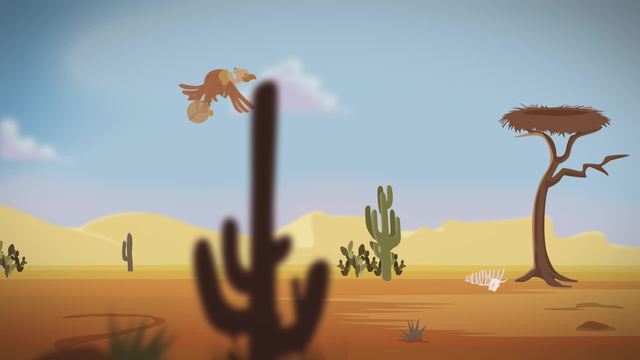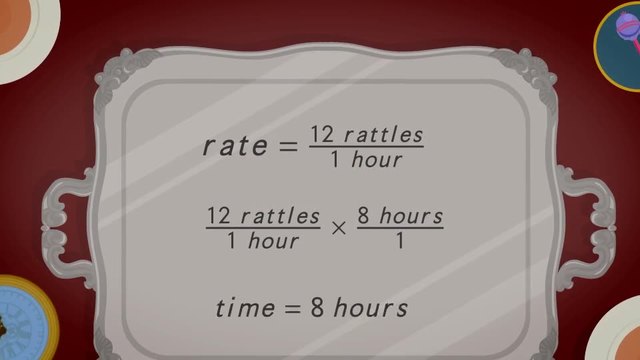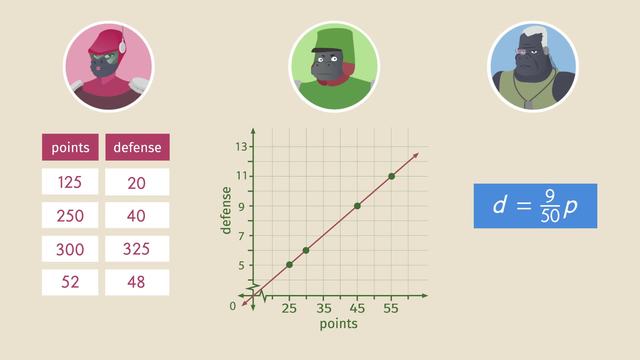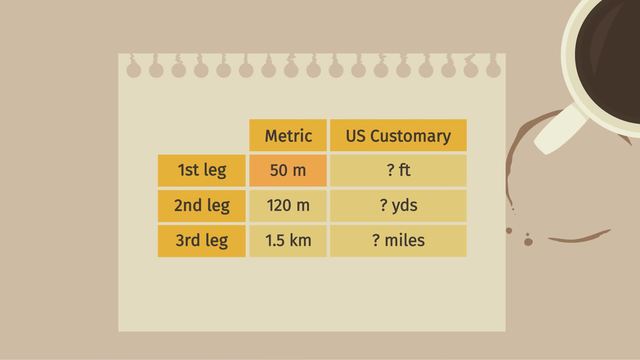Getting the Job Done—Speed


Basics on the topic Getting the Job Done—Speed
After this lesson, you will be able to calculate for distance, speed and time of travel.
The lesson begins by teaching you to recall that distance formula is equal to the product of speed and time. It leads you to learn to compute for time or distance by manipulating the formula for distance. It concludes by emphasizing the importance of including and converting the units of measurement in the solution.
Learn about speed by helping Tatu and Princess evade Walter, the vulture, on their date.
This video includes key concepts, notation, and vocabulary such as the formula for distance, d=rt (where r is the rate or speed and t is the time travelled) and the derived formulae for speed (r=d/t) and time (t=d/r)..
Before watching this video, you should already be familiar with unit conversions and solving equations by using operation properties and substitution.
After watching this video, you will be prepared to solve multi-step word problems involving speed, distance and time applying the concept of a constant unit rate.
Common Core Standard(s) in focus: 6.RP.A.3.A A video intended for math students in the 6th grade Recommended for students who are 11 - 12 years old
Transcript Getting the Job Done—Speed
Patagonian power couple Tatu and Princess finally have some time off from their busy work schedule to spend the day together.
But going on a date is not always so easy, in the wilds of the South American desert.
Interrupting their idyllic morning, it's that jerk vulture, Walter.
Why's he always ruining people's dates?
If Tatu is going to save Princess and what's left of their quiet day off, he's going to have to get the job done with speed!
It looks like Walter has kidnapped Princess and taken her back to his nest.
So how far does Tatu have to go to catch him?
To find this out, we can use a formula which you may remember...
Distance is equal to rate times time.
This common formula can be shortened to 'd' equals 'r' times 't'.
If we know that Walter flies at a rate of 80 feet per second and it will take him 3 seconds to reach his nest, we can use this information to solve for the distance, 'd'.
We already know the rate is 80 feet per second, so we can plug that in for 'r,' and we know the time is 3 seconds, so we can plug that in for 't'.
Now to solve for 'd', just simplify, starting with the units.
Just as you can cancel-out common factors, like-units cancel out as well.
For example, here, we can cancel out the seconds unit because it is in both the numerator and denominator.
Now we just multiply 80 feet by 3, to get 240 feet.
That's pretty far for an armadillo, so Tatu had better hurry if he's going to rescue Princess!
Oh no! It's even worse than usual!
Walter’s annoying Princess with his boring old photo album!
How long will she have to suffer before Tatu can rescue her?
Let's start with what we know.
In the last example, we found out that the distance to the nest is 240 feet.
If we also know that Tatu can move at a rate of 40 feet per second, we can use the same formula of distance equals rate times time and solve for the unknown variable, 't'.
To do that, let's rewrite the equation by dividng both sides by 'r'.
Now that we have isolated 't', we can substitute 240 feet in for the distance, 'd,' and 40 feet per second for the rate, 'r'.
We can rewrite the left side of the equation by changing division to multiplication.
Notice how we flipped our numerator and denominator, since dividing by a fraction is the same as multiplying by its reciprocal.
Just as we did before, the feet units cancel out.
Which leaves us with 240 seconds divided by 40.
So time is equal to 6 seconds.
We can tell that we correctly canceled our units, because we were solving for time and we are left with 'seconds'.
With Princess safe from the clutches of extreme boredom, this endangered couple are going to have to make tracks and find somewhere Walter can’t bother them.
What about that coffee shop?
The sign says it's one mile away and there are no birds allowed!
So how fast are they going to have to run to beat Walter there?
Let's look at the information we already have.
The coffee shop is one mile away, so that's our distance.
And let's say they have 2 minutes to get there.
We are solving for rate and we're going to want that in feet per second.
Hmm...hold on... miles, minutes, feet, seconds?
Before we can calculate the rate, we need to convert to the same units.
We know that 1 mile is equal to 5,280 feet, and 2 minutes equals 120 seconds.
And that's it: now we can solve our problem in feet per second.
To do this, let's use distance equals rate times time, but for this example, solve for the rate.
To set up our equation, let's isolate 'r' by dividing both sides by 't'.
This simplifies to 'd' over 't' equals the rate 'r'.
Now we can substitute 5,280 feet for the distance 'd' and 120 seconds for the time 't'.
After simplifying, we are left with a rate of 44 feet per second.
To review...
Using the formula distance equals rate times time, we can calculate distance or rewrite the equation and solve for time or solve for rate.
Once you have isolated the variable you want to solve for, simply substitute the known values and simplify, starting with the units.
If the units don't cancel, you might have to use what you know about converting to other units.
Whoa, at that rate, those guys are definitely going to beat Walter to the coffee shop but, oh no, it looks like they're closed for the holidays.
I guess Tatu and Princess are going to have to spend their date with Walter and his photo album
...wont wont...
Getting the Job Done—Speed exercise
-
Find the distance travelled.
HintsThe equation relating distance, rate, and time is $d=r\cdot t$. Distance equals rate times time.
For example: If you drive at $50~\frac{\text{mi}}{\text{hr}}$ for $2~\text{hr}$, you will travel $100~\text{mi}$:
$d=50~\frac{\text{mi}}{\text{hr}} \cdot 2~\text{hr}$
$d=100~\text{mi}$
When using the equation $d=r\cdot t$, the values for $d$, $r$, and $t$ will have units. These units will need to be simplified by cancelling in order to determine the units for your solution.
For example, in the equation:
$d=5~\frac{\text{km}}{\text{hr}} \cdot 3~ \text{hr}$
The hours cancel:
$\frac{\text{km}}{\text{hr}} \cdot \text{hr} = \text{km}$
Giving us:
$d=15~\text{km}$
Note that our solution was a distance, and distance can be measured in kilometers.
A rate of speed is a distance covered per unit time. Some examples are:
- miles per hour
- kilometers per minute
- feet per second
SolutionThe distance travelled is the rate times the time. This relationship is expressed by the equation:
$d=r\cdot t$
$d$ represents the distance, $r$ represents the rate, and $t$ represents the time.
Walter flew to the oasis at $20~\frac{\text{ft}}{\text{sec}}$. That's the rate. We recognize it's a rate because of its units, feet per second.
Walter flew for $4~\text{sec}$. That's the time.
The distance is unknown.
To find the distance, we substitute the known values (with units) for $r$ and $t$ into the equation:
$d=$ $20~\frac{\text{ft}}{\text{sec}}$ $\cdot$ $9~\text{sec}$
First, let's simplify the units. The seconds cancel:
$\frac{\text{ft}}{\text{sec}}\cdot\text{sec}=\frac{\text{ft}}{\text{sec}}\cdot\frac{\text{sec}}{1}=\text{ft}$
This give us:
$d=20~\text{ft}\cdot 9$
Multiplying the values gives us:
$d=180~\text{ft}$
That's the distance Walter flew.
-
Determine the time it took to travel.
HintsThe equation $d=r\cdot t$ features three variables. Typically, we are given the values for two of the variables, and we must find the third, unknown variable. This sometimes requires use of properties of equality to solve for the unknown.
- If you want to know $d$, $d=r\cdot t$ is already solved for $d$.
- If you want to know $t$, solve for $t$ by dividing.
- If you want to know $r$, solve for $r$ by dividing.
Dividing by a fraction is equivalent to multiplying by its reciprocal. This is useful when simplifying units in problems involving distance, rate, and time.
Here is an example:
$\frac{60~\text{km}}{30~\frac{\text{km}}{\text{hr}}} = \frac{60~\text{km}}{30} \cdot \frac{\text{hr}}{\text{km}} = 2~\text{hr}$
The units of a quantity tell you if it's a distance, rate, or time. For example:
- $30~\text{yd}$ is a distance.
- $12~\frac{\text{yd}}{\text{min}}$ is a rate.
- $7~\text{min}$ is a time.
SolutionWe can use the equation $d=r\cdot t$.
We know $d$ and $r$.
- The distance to the oasis was given as $180~\text{ft}$.
- The rate was given to us as $5~\frac{\text{ft}}{\text{sec}}$.
We solve our equation for $t$ by dividing by $r$:
$\begin{array}{l|l} \text{Equation} & \text{Explanation}\\ \hline d=r\cdot t & \text{The equation for distance.}\\ \frac{d}{r}=\frac{r\cdot t}{r} & \text{Dividing both sides by}~r.\\ \frac{d}{r}=t & \text{Canceling}~r~\text{on the right.}\\ t=\frac{d}{r} & \text{Commutative property of equality.} \end{array}$
The result is $t=\frac{d}{r}$.
Substituting $180~\text{ft}$ for $d$ and $5~\frac{\text{ft}}{\text{sec}}$ for $r$ gives us:
$\begin{array}{l} t=\frac{180~\text{ft}}{5~\frac{\text{ft}}{\text{sec}}}\\ t=\frac{180~\text{ft}}{5}\cdot\frac{\text{sec}}{\text{ft}}\\ t=\frac{180}{5}~\text{sec}\\ t=36~\text{sec} \end{array}$
-
Find the missing values.
HintsHere is an example of how to simplify expressions involving division of units:
$\begin{array}{l|l} \text{Equation} & \text{Explanation}\\ \hline \frac{150~{\text{m}}}{15\frac{\text{m}}{\text{sec}}} & \text{Given expression.}\\ \frac{150~{\text{m}}}{15}\cdot\frac{\text{sec}}{\text{m}} & \text{Dividing is multiplying by the reciprocal.}\\ \frac{150~\text{sec}}{15} & \text{Canceling units.}\\ 10~\text{sec} & \text{Division.} \end{array}$
The units for distance are distances. Some examples are:
- $\text{km}$
- $\text{mi}$
- $\text{m}$
- $\text{ft}$
- $\text{sec}$
- $\text{min}$
- $\text{hr}$
- $\frac{\text{km}}{\text{min}}$
- $\frac{\text{m}}{\text{s}}$
- $\frac{\text{mi}}{\text{hr}}$
It is not always necessary to solve an equation to determine if a value is a solution. Given the following equation and the following potential solution, you can substitute and check to see if the value makes the equation true:
\begin{array}{l|l} \text{Equation} & \text{Explanation}\\ \hline \frac{x}{4}=12 & \text{Given equation.}\\ x=48 & \text{Potential solution.}\\ \frac{48}{4}=12 & \text{substituting to determine if }x=4 \text{ is a solution}\\ 12=12 &\text{Division confirms equality, so }x=4~ \text{is a solution.}\\ \end{array}
Solution$\begin{array}{l|l} \text{Equation} & \text{Explanation}\\ \hline \frac{144~\text{m}}{48~\frac{\text{m}}{\text{min}}}=t & \text{Given equation.}\\ t=\frac{144~\text{m}}{48}\cdot \frac{\text{min}}{\text{m}} & \text{Dividing fractions is multiplying by reciprocal.}\\ t=3~\text{min} & \text{Dividing and canceling.}\\ \end{array}$
$\begin{array}{l|l} \text{Equation} & \text{Explanation}\\ \hline 9~\text{min}\cdot\frac13~\frac{\text{yd}}{\text{min}}=d & \text{Given equation.}\\ d=9~\text{min}\cdot\frac13~\frac{\text{yd}}{\text{min}} & \text{Commutative property of equality.}\\ d=\frac{9}{3}~\text{yd} & \text{Canceling units.}\\ d=3~\text{yd} & \text{Dividing.} \end{array}$
$\begin{array}{l|l} \text{Equation} & \text{Explanation}\\ \hline d=3~\frac{\text{ft}}{\text{sec}}\cdot 12~\text{sec} & \text{Given equation.}\\ d=3~\text{ft}\cdot 12 & \text{Canceling units.}\\ d =36~\text{ft} & \text{Multiplying.}\\ \end{array}$
$\begin{array}{l|l} \text{Equation} & \text{Explanation}\\ \hline 36~\frac{\text{ft}}{\text{sec}}=\frac{d}{3~\text{sec}}& \text{Given equation.}\\ d=108~\text{ft} & \text{Choosing this potential solution for distance.}\\ 36~\frac{\text{ft}}{\text{sec}}=\frac{108~\text{ft}}{3~\text{sec}} & \text{Substituting the chosen value for }d.\\ 36~\frac{\text{ft}}{\text{sec}}=36~\frac{\text{ft}}{\text{sec}}& \text{Division.}\\ 36=36 & d=108~\text{ft confirmed as a solution.} \end{array}$
$\begin{array}{l|l} \text{Equation} & \text{Explanation}\\ \hline t=\frac{60~\text{mi}}{5\frac{\text{mi}}{\text{sec}}} & \text{Given equation.}\\ t=\frac{60~\text{mi}}{5}\cdot\frac{\text{sec}}{\text{mi}} & \text{Dividing fractions is multiplying by the reciprocal.}\\ t=\frac{60}{5}~\text{sec} & \text{Canceling units.}\\ t=12~\text{sec} & \text{Division.}\\ \end{array}$
$\begin{array}{l|l} \text{Equation} & \text{Explanation}\\ \hline r=\frac{144~{\text{km}}}{12~\text{sec}} & \text{Given equation.}\\ r=12~\frac{\text{km}}{\text{sec}} & \text{Division}\\ \end{array}$
-
Comparing rates.
HintsHere are some helpful conversion factors:
- $3600~\text{sec}=1~\text{hr}$
- $5280~\text{ft}=1~\text{mi}$
- $1760~\text{yd}=1~\text{mi}$
- $3~\text{ft}=1~\text{yd}$
When comparing rates with different units, select a single unit that you can easily convert all the rates to, and which is intelligible to you. Some rates that may make sense to you are:
- miles per hour
- feet per second
Here's an example of converting from $\frac{\text{ft}}{\text{min}}$ to $\frac{\text{mi}}{\text{hr}}$:
$\begin{array}{l|l} \text{Equation} & \text{Explanation}\\ \hline r=\frac{21,120~\text{ft}}{10~\text{min}} & \text{Given equation.}\\ r=\frac{2112~\text{ft}}{\text{min}} & \text{Division.}\\ r=\frac{2112~\text{ft}}{1~\text{min}}\cdot \frac{1~\text{mi}}{5280~\text{ft}} & \text{From feet to miles.}\\ r=\frac{0.4~\text{mi}}{1~\text{min}}\cdot \frac{60~\text{min}}{1~\text{hr}} & \text{From minutes to hours.}\\ r=24~\frac{\text{mi}}{\text{hr}} & \text{Simplifying.} \end{array}$
Solution$\begin{array}{l|l} \text{Equation} & \text{Explanation}\\ \hline \frac{21~\text{mi}}{3~\text{min}}=r & \text{Given equation.}\\ r=7~\frac{\text{mi}}{\text{min}} & \text{Dividing.}\\ r=\frac{7~\text{mi}}{\text{min}}\cdot \frac{60~\text{min}}{1~\text{hr}} & \text{From minutes to hours.}\\ r=420~\frac{\text{mi}}{\text{hr}} & \text{Simplifying.} \end{array}$
$\begin{array}{l|l} \text{Equation} & \text{Explanation}\\ \hline 300~\text{ft}=r\cdot 6~\text{sec} & \text{Given equation.}\\ r=\frac{300~\text{ft}}{6~\text{sec}} & \text{Division property of equality.}\\ r=\frac{50~\text{ft}}{\text{sec}} & \text{Division.}\\ r=\frac{50~\text{ft}}{\text{sec}}\cdot \frac{3600~\text{sec}}{1~\text{hr}} & \text{From seconds to hours.}\\ r=180,000~\frac{\text{ft}}{\text{hr}} & \text{Canceling units and simplifying.}\\ r=180,000~\frac{\text{ft}}{\text{hr}} \cdot \frac{1~\text{mi}}{5280~\text{ft}} & \text{From feet to miles.}\\ r=34.\overline{09}~\frac{\text{mi}}{\text{hr}}& \text{Canceling units and simplifying.}\\ \end{array}$
$\begin{array}{l|l} \text{Equation} & \text{Explanation}\\ \hline \frac{325~\text{yd}}{25~\text{sec}} =r& \text{Given equation.}\\ r=\frac{13~\text{yd}}{1~\text{sec}} & \text{Division.}\\ r=\frac{13~\text{yd}}{\text{sec}}\cdot \frac{3600~\text{sec}}{~\text{hr}} & \text{From seconds to hours.}\\ r=\frac{46,800~\text{yd}}{\text{hr}}\cdot \frac{1~\text{mi}}{1760~\text{yd}} & \text{From yards to miles.}\\ r=26\frac{13}{22}~\frac{\text{mi}}{\text{hr}} & \text{Simplifying.} \end{array}$
$\begin{array}{l|l} \text{Equation} & \text{Explanation}\\ \hline r=\frac{3~\text{mi}}{8~\text{min}} & \text{Given equation.}\\ r=\frac{3~\text{mi}}{8~\text{min}}\cdot \frac{60~\text{min}}{~\text{hr}} & \text{From minutes to hours.}\\ r=22.5~\frac{\text{mi}}{\text{hr}} & \text{Simplifying.} \end{array}$
$\begin{array}{l|l} \text{Equation} & \text{Explanation}\\ \hline 20,000~\text{yd} =r\cdot5~\text{hr}& \text{Given equation.}\\ r=\frac{20,000~\text{yd}}{5~\text{hr}} & \text{Division property of equality.}\\ r=\frac{4000~\text{yd}}{\text{hr}} & \text{Division.}\\ r=\frac{4000~\text{yd}}{\text{hr}}\cdot \frac{1~\text{mi}}{1760~\text{yd}} & \text{From yards to miles.}\\ r=2\frac{3}{11}~\frac{\text{mi}}{\text{hr}} & \text{Simplifying.} \end{array}$
-
Identify the distance formula.
HintsMultiplication is commutative. That means:
$a\cdot b = b \cdot a$
Equality is commutative. That means:
If $a=b$ then $b=a$.
Below is an example of the process for dividing both sides of an equation to solve for a variable. In this example, we will solve for $t$:
$\begin{array}{l|l} \text{Equation} & \text{Explanation}\\ \hline d=r\cdot t & \text{The equation for distance.}\\ \frac{d}{r}=\frac{r\cdot t}{r} & \text{Dividing both sides by}~r.\\ \frac{d}{r}=t & \text{Canceling}~r~\text{on the right.}\\ t=\frac{d}{r} & \text{Commutative property of equality.} \end{array}$
Solution- $d=r\cdot t$ True This is the most common way of writing the equation relating distance, rate, and time.
- $r=d\cdot t$ False The correct method for solving for $r$ is shown below.
- $r=\frac{d}{t}$ True See above.
- $t=\frac{r}{d}$ False The correct method for solving for $t$ is shown below:
- $\frac{d}{r}=t$ True See above. Look at the second to last line.
- $t\cdot r =d$ True See below.
- $r=d\cdot t$ False See above for the correct method for solving for $r$.
- $\frac{t}{r}=d$ False $d=r\cdot t$.
-
Calculate the missing rate.
HintsFirst, find the distance to the waterfall.
If one rate is $r$, then twice that rate is $2r$.
Create one expression for the distance traveled by Tatu and Princess during the day, and another for the distance traveled during the night.
The sum of the distance traveled during the day and the distance traveled during the night is the distance to the waterfall.
SolutionWalter flew at $20$ miles per hour for $1$ day to arrive at the waterfall:
$\begin{array}{l} r=20~\text{mi}\\ t=24~\text{hr} \end{array}$
Distance is rate times time:
$\begin{array}{l} d=20~\frac{\text{mi}}{\text{hr}}\cdot 24~\text{hr}\\ d=480~\text{mi}\\ \end{array}$
The waterfall is $480~\text{mi}$ away. For Tatu and Princess, there are two different rates they travel, a rate during the day, $r$, and a rate at night, $2r$.
The travel each rate for $12$ hours, accomplishing one distance during the day and another distance at night:
$\begin{array}{l} d_\text{day}=r\cdot12~\text{hr}=12r\\ d_\text{night}=2r\cdot12~\text{hr}=24r\\ \end{array}$
If they are going to make it to the waterfall in a day, the sum of these two distances must be $480~\text{mi}$:
$\begin{array}{l} 12r+24r=480\\ 36r=480\\ r=13\frac13~\frac{\text{mi}}{\text{hr}}\\ \end{array}$
That’s $r$, their day rate. Their night rate is $2r$, that is, $26\frac23~\frac{\text{mi}}{\text{hr}}$.

From Ratios to Rates and Rates to Ratios

Finding Rates with Division

Comparison Shopping: Unit Price and Related Measurements

Getting the Job Done—Speed

Getting the Job Done—Work

Getting the Job Done: Converting Units of Measurement

Problem Solving Using Rates, Unit Rates, and Conversions

What is a Proportional Relationship?












aaaaaaaaaaaaaaaaaaaaaaaaaaaaaaaaaah